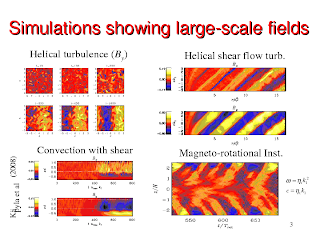
Links to the talk ( ppt, pdf)
Prolific output in 2008 after quiescent period after 2005
In many astrophysical systems a large scale magnetic field is generated, but the mechanism for their formation is still elusive.
Helical turbulence: Homogeneous and isotropic. However, all helices have the same handiness.
Large scale magnetic fields usually appear in spacetime plots of fields as a finite amplitude field after dimensional average.
Source of turbulence in forced dynamos: a body force. Non-natural, closest analog being supernova explosions.
Convection (with shear) and MRI are two sources of turbulence that can generate large magnetic fields. Structure visible in the z-direction.
Low Prandlt number dynamos (Pm=visc/resist):
Helical turbulence: inject energy at intermediate wavelengths. Energy cascades to the right (smaller wavelengths) and to the left (larger scales). This is due to helicity. At non-helical turbulence at other Pradtl numbers, one can excite the dynamos at progressively lower Reynolds numbers as the Prandlt number increases. In the Sun the Prandt number is 1e-5. So, very large Reynolds numbers are needed.
With helical turbulence the dynamo is still excited at low Prandlt numbers. The only difference is that the viscous range moves towards larger scales (still smaller than the scale where energy in being forcely supplied). The inertial range shrinks. So, astrophysics don't have any problems with small Prandlt numbers. The only thing we need is stratification to drive helicity loss.
Testfield equations:
perturb the original induction equation and separate them in mean field and fluctuations. The eq. for the fluctuations cannot induce a large scale field.
Validation: Roberts flow
Non-linear alpha and eta tensors
Turbulent diffusion as a function of Reynolds number. Quenching goes as a factor 5. Turbulent diffusion is not catastrophically quenched. Several consistency checks.
No comments:
Post a Comment